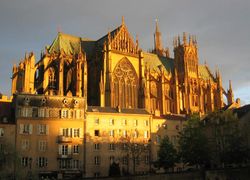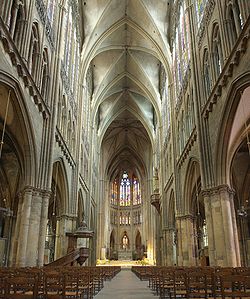- Metz Cathedral
-
For other uses of Metz, see Metz (disambiguation).
Cathédrale Saint Étienne de Metz 
Sunset on the Cathédrale Saint Étienne de Metz
Basic information Location 1 Place Jean-Paul II, 57000 Metz, France Geographic coordinates Coordinates: 49°07′12″N 6°10′32″E / 49.12°N 6.17556°E Affiliation Roman Catholic Region Lorraine District Catholic diocese of Metz Municipality Metz Year consecrated 1552 Status Active Leadership Pierre Raffin Website http://www.cathedrale-metz.fr/ Architectural description Architectural type Church Architectural style French Gothic; German Gothic Revival Direction of façade West Groundbreaking 1220 Completed 1520 Designated as NHL: Monument historique (1930) Saint Étienne de Metz (French for Saint Stephen of Metz), also known as Metz Cathedral) is a Gothic, Catholic cathedral in the city of Metz, capital of Lorraine, France. It is the cathedral of the Catholic Diocese of Metz and the seat of the Bishop of Metz.
The cathedral is sometime nicknamed the Good Lord's lantern (French: la lanterne du Bon Dieu) as it possesses the largest expanses of stained glass windows in the world with 6,500 m2 (70,000 sq ft). The stained glass windows include works of Hermann von Münster (14th C); Théobald of Lixheim and Valentin Bousch (16th C); Laurent-Charles Maréchal (19th C); Roger Bissière, Jacques Villon and Marc Chagall (20th C).
Its nave, 41.41 meters high, is one of the highest in France only overtopped by Beauvais Cathedral and Amiens Cathedral, and is the 10th highest nave in the world.
Contents
History
Early history
The site was consecrated from the fifth century to Saint Stephen Protomartyr, who enjoyed a wave of popularity following the finding of his relics at Jerusalem in 415. Several French cathedrals are dedicated to him: Agde, Auxerre, Bourges, Cahors, Châlons-en-Champagne, Limoges, Meaux, Sens, Toul, Toulouse, most of them also dating from the fifth century.
Metz had been the seat of a bishop since the third century. Gregory of Tours[1] reports the tradition that the shrine of Saint Stephen was the sole structure miraculously spared when the Huns sacked and levelled the city, 7 April 451. According to the history of the bishops of Metz, written about 784 by a Lombard Benedictine, Pepin the Short financed works undertaken by bishop Chrodegang (742-766): ciborium, chancel, presbyterium and ambulatory. All these were replaced by the Romanesque building campaign of 965-984 undertaken by Bishop Thierry I, under the patronage of Emperors Otto I and Otto II. The new basilica was completed and reconsecrated in 1040 by his successor, Thierry II.
Because of difficulties with the place at the edge of the Mosel valley, the new church could not be orientated to the east, as it is usual: the main direction of the cathedral is north-north-east. In 1186, a small chapel (the collegiate church "Notre-Dame-de-la-Ronde") was added at the western end of the church, built at 90° to the main nave. The two buildings were separated by a massive wall.
The Gothic cathedral
Within two centuries a reconstruction commenced. About 1220, the building campaign in Gothic style was begun, to the order of Bishop Conrad of Scharfeneck. It was not completed until about 1520. The new cathedral was consecrated on 11 April 1552. The Gothic cathedral was built within the walls of its predecessor; after finishing the new church, the wall to the collegiate chapel at the west was torn down. This explains why the cathedral never had a main western portal and why the main entrance was for centuries at the south-western corner, the usual entrance to the church today.[2]
 Stained glass windows of Marc Chagall.
Stained glass windows of Marc Chagall.
Unexpectedly, the cathedral got an early neoclassical portal, designed in 1764, in spite of the canons' resistance, by the Parisian architect Jacques-François Blondel. The project was due to the governor of the Trois-Évêchés, the maréchal de Belle-Isle, who decided that Metz should not be outdone by Nancy, with its Place Stanislas, and determined to build a Place Royal around the Gothic cathedral. He disengaged the cathedral's façade by razing the cloister and three attached churches, Saint-Pierre-le-Vieux, Saint-Pierre-le-Majeur and the chapel of the House of Lorrain. Blondel was engaged to give the dense medieval city centre of Metz a space that was intended to act as a stylish urban focus. The resulting design, realised from 1762 onwards, produced the Place d’Armes for military musters and parades, with its mayoral palace, the Place de Chambre, with the new bishops' palace, and the Place du Marché, the market square, ranged on three sides of the cathedral. Together they provide a unified classicising setting that plays against the Gothic fabric of the cathedral.
19th and 20th century
In 1877, due to a firework display honoring German emperor William I, the cathedral was heavily damaged after a fire broke out.[3] After that incident, the neoclassical portal was demolished and the western front of the cathedral was completely rebuilt from 1898-1903 in neo-Gothic style, to designs by Paul Tornow. So the cathedral got, for the first time in its history, a "proper" western main portal. In the following years (1906-1916), the interior was also redesigned and refurbished.[4]
Windows
The stained glass windows, the largest expanses of stained glass in the world, were made by the master craftsmen Hermann von Münster in the fourteenth century, and Valentin Bousch in the sixteenth. In the twentieth century the artist Marc Chagall created three stained glass windows for the cathedral between 1958 and 1968. Roger Bissière and Jacques Villon provided designs for further windows, including the complete chapel of the Holy Sacrament.
See also
- List of highest church naves
- List of tallest churches
References
- ^ Gregory, Historia Francorum, II.6.
- ^ See the map of the cathedral
- ^ source: fr. WP
- ^ source: germ. WP
External links
Notes
Categories:- Metz
- Cathedrals in France
- Architecture in Metz
- Romanesque architecture in France
Wikimedia Foundation. 2010.




